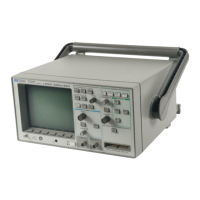because you can ignore hardware handshake requirements. The logic
analyzer uses the following connections on its RS-232-C interface for
three-wire communication:
•
Pin 7 SGND (Signal Ground)
•
Pin 2 TD (Transmit Data from logic analyzer)
•
Pin 3 RD (Receive Data into logic analyzer)
These connections assume you have an interface module with a 25-pin
RS-232 connector. If the RS-232 connector on your module is not a 25-pin
connector, refer to the documentation that came with the module for
connection information.
The TD (Transmit Data) line from the logic analyzer must connect to the RD
(Receive Data) line on the controller. Likewise, the RD line from the logic
analyzer must connect to the TD line on the controller. Internal pull-up
resistors in the logic analyzer interface module ensure the DCD, DSR, and
CTS lines remain high when you are using a three-wire interface.
No Hardware Means to Control Data Flow
The three-wire interface does not provide a hardware means to control data
flow between the controller and the logic analyzer. XON/XOFF protocol is the
only means to control this data flow.
Extended Interface with Hardware Handshake
With the extended interface, both the software and the hardware can control
the data flow between the logic analyzer and the controller. This allows you
to have more control of data flow between devices. The logic analyzer uses
the following connections on its RS-232-C interface for extended interface
communication (on a 25-pin connector):
•
Pin 7 SGND (Signal Ground)
•
Pin 2 TD (Transmit Data from logic analyzer)
•
Pin 3 RD (Receive Data into logic analyzer)
The additional lines you use depend on your controller’s implementation of
the extended hardwire interface.
•
Pin 4 RTS (Request To Send) is an output from the logic analyzer which
can be used to control incoming data flow.
Programming over RS-232-C
Cables
44

